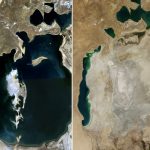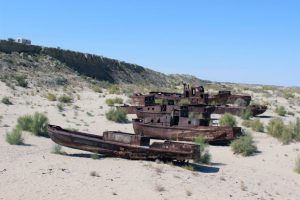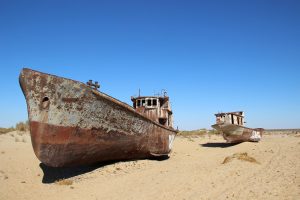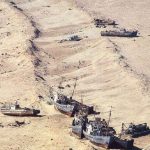
 If you were to travel to Kazakhstan and Uzbekistan, you would see what was once the fourth largest inland body of water in the world. The Aral Sea once had a water surface of 26,254 square miles. The salinity measured at 10g/L (grams of salt per liter of water). In comparison, the oceans are about 35 g/L, and the Dead Sea about 300 g/L. The Aral Sea has no outflow, and is fed by the Amu Darya and Syr Darya (Darya means river). It’s this lack of outflow that explains the high salinity. Still, it is much lass salty than the ocean, and especially much less than the Dead Sea.
If you were to travel to Kazakhstan and Uzbekistan, you would see what was once the fourth largest inland body of water in the world. The Aral Sea once had a water surface of 26,254 square miles. The salinity measured at 10g/L (grams of salt per liter of water). In comparison, the oceans are about 35 g/L, and the Dead Sea about 300 g/L. The Aral Sea has no outflow, and is fed by the Amu Darya and Syr Darya (Darya means river). It’s this lack of outflow that explains the high salinity. Still, it is much lass salty than the ocean, and especially much less than the Dead Sea.
The thing is…the Aral Sea was shrinking. By 1998, it had shrunk to just over 10,810 square miles. At that point, it became only the eighth largest lake in the world, and the salinity had increased to 45 g/L. By 2007, the lake had diminished to only 6,625 square miles, and became two separate basins…The North Aral Sea and the South Aral Sea. Now it is not even in the top ten list of the world’s largest lakes. The South Aral Sea is now further divided into two separate basins, east and west. Salinity in the southern basins is up to over 100 g/L, and has resulted in the death of most of the native flora and fauna of the lake. The lake used to have a fishing industry that supplied Russian markets with almost a quarter of their fish, while employing 40,000 people…but no more. Even the climate in the region has changed, with the loss of so much water, becoming more arid, with significantly decreased precipitation further adding to the decline of the Aral Sea. In total, the surface area has declined 90%, and the volume has decreased by 85%…basically like removing lakes the size of Lake Erie and Lake Ontario combined.
While these facts are strange in and of themselves, I wonder exactly how fast this transformation actually occurred. It is said that the sea level has dropped by over 98 feet in many places, leaving fishing boats stranded more than 60 miles from any shore. The ships were simply high and dry in the middle of the sea that had once been the source of income for their crews. The bottom of the lake became a new desert. The towns that had once been thriving were perched on vanished shorelines with toxic dust storms swirling around in the 
 wind. The people struggle in poverty and high rates of cancer, tuberculosis, digestive disorders, and anemia. The area today seems relatively safe to visit today, at least in the short term. What is interesting about the Aral Sea today is the it is still full of scores of ships…all high and dry on the sand. Why didn’t the owners take their ships away before the sea went dry? I guess maybe they believed the rains would come, and maybe they will, eventually. Unfortunately, it will simply be too late.
wind. The people struggle in poverty and high rates of cancer, tuberculosis, digestive disorders, and anemia. The area today seems relatively safe to visit today, at least in the short term. What is interesting about the Aral Sea today is the it is still full of scores of ships…all high and dry on the sand. Why didn’t the owners take their ships away before the sea went dry? I guess maybe they believed the rains would come, and maybe they will, eventually. Unfortunately, it will simply be too late.


2 Responses to Ships On The Sand